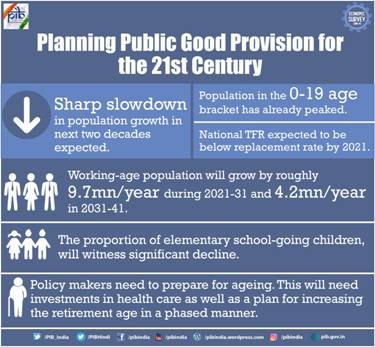Ministry of Finance
India’s Demography at 2040 : Planning Public Good Provision for the 21st Century
Economic Survey suggests increasing the retirement age could be considered given that life expectancy is likely to continue rising
प्रविष्टि तिथि:
04 JUL 2019 12:12PM by PIB Delhi
Highlighting India’s demography, the Economic Survey 2018-19 states that “India is set to witness a sharp slowdown in population growth in the next two decades. Although the country as a whole will enjoy the demographic dividend phase, some States which are in the advanced stage of demographic transition will witness transition to an ageing society as early as 2030s.” The Survey was tabled by the Union Minister for Finance and Corporate Affairs, Smt. Nirmala in the Parliament today. Population projection at the national and State level upto 2041 show that India has entered the next stage of demographic transition, with population growth set to slow sharply in the next two decades. This is mainly due to the rapid decline in the total fertility rate (TFR) in recent decades, which is expected to be below replacement level fertility by 2021. While all major States have witnessed a marked deceleration in population growth, the slowdown in States with historically high population growth such as Bihar, Uttar Pradesh, Rajasthan and Haryana is particularly noteworthy.

The projected population and age structure over the next two decades has several implications for policy making in the fields of health care, old age care, school facility, retirement related financial services, public pension funding, income tax revenue, labour force and labour participation rate and retirement age.
Talking about the population growth trajectory, the Economic Survey states “both the trajectory of population and population growth will vary across States. States ahead in the demographic transition will witness a continued deceleration in population growth and reach near-zero growth rate by 2031-41. States lagging behind in the demographic transition will also witness a marked slowdown in population growth during 2021-41.
A surprising fact is that population in the age bracket 0-19 has already peaked due to sharp decline in TFR across the country. The national TFR is expected to be below replacement rate by 2021. The share of India’s young i.e. 0-19 years is projected to drop from as high as 41% in 2011 to 25% by 2041. On the other hand the share of elderly, 60 years and above, population will continue to rise steadily nearly doubling from 8.6% in 2011 to 16% by 2041. The working age population will grow by roughly 9.7 million per annum during 2021-31 and 4.2 million per annum during 2031-41.
Talking about the implication for working age population, the Economic Survey states that “its size plays a key role in determining the size of labour force and direction of inter-state migration. It further states that depending upon the trajectory of labour force participation during 2021-41, additional jobs will need to be created to keep pace with the projected annual increase in working age population”. The States with rising working age population could meet the labour deficit in many ageing States. The current migration trends broadly follow this pattern.
The change in demographic break-up has several policy implications such as those on elementary schools, health care facilities and deciding the retirement age. Overall, the number of school going children in India will decline by 18.4% between 2021-41. This will have very important social and economic consequences. In light of the projected decline, in elementary school going children the number of schools per capita will rise significantly in India across all major States even if no more schools are added. The time may soon come in many States to consolidate/merge elementary schools in order to keep them viable.
Access to health care is still a major challenge in India. If India’s hospital facility remain at current level, rising population over the next two decades despite the slowdown in population growth rate will sharply reduce per capita availability of hospital beds. Hence, there is straight forward case for expanding medical facilities in the States.
India’s health life expectancy at the age of 60 which is the average number of years a 60 year old person is expected to live in full health taking into account the impact of diseases and injuries has continually increased over the years for both men and women. Healthy life expectancy at the age of 60 now stands at 12.9 years (12.5 years for males and 13.3 years for female). Given that life expectancy for male and female in India is likely to continue rising, increasing the retirement age for men and women could be considered in line with the experience of other countries. This will be key to the viability of pension systems and also help increase female labour force participation in the older age groups.
****
DSM/RM/APS/AS/SR
(रिलीज़ आईडी: 1577022)
आगंतुक पटल : 4116